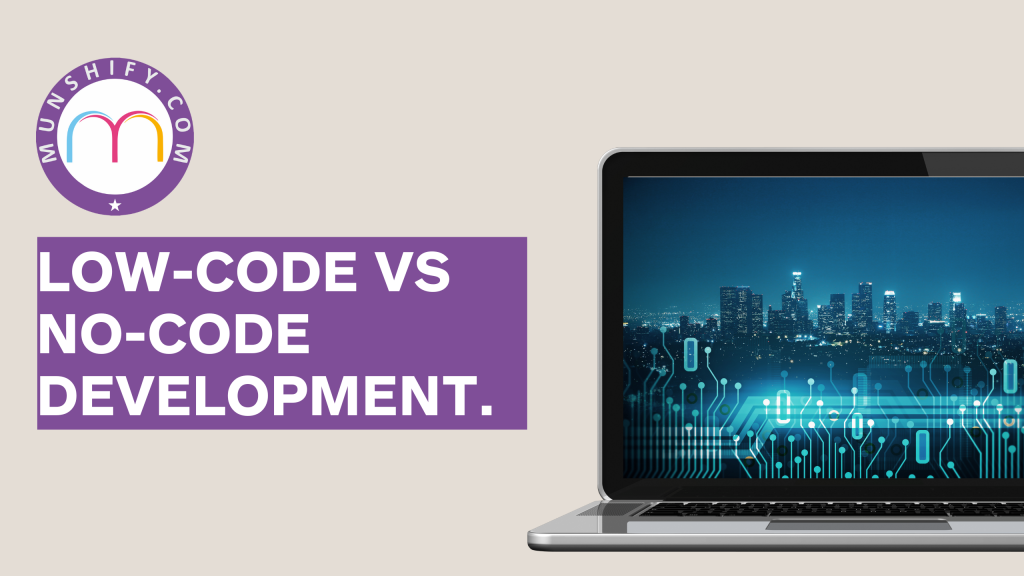Low-Code Vs No-Code Development

Two terms that are making waves in the dynamic field of software development are Low Code and No Code. These innovative techniques promise to transform application development and provide a more efficient path for both people and enterprises. However, what precisely are these phrases and what distinguishes them? To help you navigate this changing terrain, let us explore the intricacies of the Low Code vs. No Code debates.
What is Low-Code?
Low-code is a method of software development that builds processes and apps with little to no coding. You can use low-code development platforms that provide visual interfaces with simple logic and drag-and-drop features in place of complicated programming languages. These simple methods allow users to create software for a variety of uses, including commercial and mobile applications, even if they have no prior experience with coding or software development.
The flexibility of low-code platforms is comparable to that of training wheels on a development bike. They maintain their user-friendly interface while offering the ability to add more control through coding tricks. Low Code reduces the amount of effort spent on standard coding techniques by emphasizing speed and efficiency.
Key features of Low Code:
Development is made easier with this intuitive visual interface.
Ready-made parts that assemble quickly.
Options for customization to fit apps precisely to your needs.
The ability to integrate seamlessly with other services and systems.
What is No-Code?
No-code is a framework for programming that lets non-technical people construct apps by dragging and dropping software components to make an entire application. It does this through a visual development interface. Using no-code, users may create applications without any prior coding knowledge. No-code platforms elevate simplicity to a new level by enabling anyone lacking coding knowledge to independently construct programs. With the help of these platforms’ intuitive interfaces and templates, users may create applications visually without ever writing a line of code. App creation is now available to everyone because of no-code platforms that emphasize usability and accessibility.
Think of it as drag-and-drop ease! Platforms that require no code are ideal for people who have never coded. Assembling pre-built features and functions to develop your app is like building with Legos.
Key features of No Code:
Development that is effortless and has an intuitive user interface.
Vast template libraries to get you started quickly.
Processes that are automated and optimize procedures.
Accessibility for people who do not know how to code.
Low Code or No Code?
After discussing the fundamentals of both low code and no code, how can you pick the best course for your development project? Consider the following elements:
1. Technical proficiency:
If you have a group of talented engineers who can quickly build using visual tools, then low code is perfect.
If you do not know how to code or want to include stakeholders who are not technical in the process, No Code is the way to go.
2. Complexity of the Project:
For complicated applications that need a lot of integration and customization, go with minimal code.
For easier projects, go with No Code, putting development speed and ease first.
3. Time-to-Market:
Because low code requires less coding and debugging effort, it speeds up development and is ideal for projects with short turnaround times.
Rapid prototyping and iteration are made possible by No Code, which speeds up idea testing and accelerates time to market.
4. Expense Factors:
Because it requires developer knowledge and license fees, Low Code may need a larger initial investment.
There is no more affordable solution than No Code, which also saves development time and does away with the requirement for expert coders.
Read more about App Development With Low-Code And No-Code
What are the Low-Code No-Code Platforms?
Strong application development methodologies like low-code and no-code let non-programmers or those with no coding experience create and launch apps more quickly. The purpose of both no-code and low-code systems is to enable non-technical users to develop unique solutions, freeing up technical resources for more difficult tasks.
Differences between Low-Code and No-Code
Aspect | Low-Code | No-Code |
Target User | Tech-savvy users and developers | Business users without technical expertise |
Flexibility | Highly customizable | Mostly fixed features |
Coding Required | Minimal, for complex tasks | None, purely visual |
Complexity | Handles complex systems | Suited for simpler systems |
Integration | Advanced integration options | Basic integrations |
Control | High control, code-level access | Limited control, confined to platform limits |
Development Speed | Quick, varies with complexity | Very quick, consistent across projects |
Scalability | More scalable, robust | Generally, less scalable |
Use Cases | Complex enterprise solutions | Simple applications, basic workflows |
In conclusion, there are distinct benefits for modern app development that come with both low code and no code. There is a solution suited to your requirements, regardless of how important speed, flexibility, accessibility, or cost-effectiveness are to you. You can start down a successful development path by analyzing your requirements and knowing the differences between low code and no code.
Munshify is a low-code/no-code development platform designed to simplify software solution development for corporate users. To increase productivity and efficiency in the workplace, teams can create unique applications with several automated workflows and optimize procedures. Without depending on IT or consultants, it enables business people to design their own apps.
Take your software development to the next level by using Munshify!
We are located at

eReleGo Technologies Pvt Ltd
646, 52, 12th Main Rd,
2nd Block, Rajajinagar,
Bengaluru, Karnataka 560010


